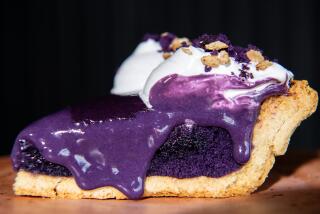FOOD : In Full Fig : Most of California’s Crop Is Dried--But When Used Fresh, These Fruits Make a Glamorous Tart
- Share via
FRESH FIGS will probably go down as this--and certainly next--year’s trendiest fresh fruit, thanks to an upswing in supply and demand. They enter their late-harvest peak months from now through October, with some lingering into December.
According to the Fresh Produce Council, more fresh figs are produced and sold today than ever before. “Consumers are buying more today because they’re beginning to know what to do with them and because they are a natural source of sugar without the high calories,” says Jan DeLyser, executive vice president of the FPC.
However, fresh figs remain a minuscule portion (3.7%) of the total fig production in California; the rest of the crop is dried. California has been the major producer of figs in the United States since missionary fathers planted them at Mission San Diego; but the history of figs goes back to the earliest civilizations of mankind in western Asia--especially Turkey--and the Mediterranean. Egyptian papyruses of 1551 BC extol the virtues of figs; Greeks attributed healing powers to them, and Pliny--a Roman author who lived from AD 62 to 113, promoted figs as a health preservative to make the elderly look younger, with fewer wrinkles. Spaniards brought figs to the Americas, with the first plantings on the island of Haiti in 1520.
Most of the figs marketed today--36,000 tons fresh weight--are grown in the San Joaquin and Sacramento valleys within a 55-mile radius of Fresno. Arizona and some Southern states produce a small part of the dried figs in the United States. Some fresh figs that make it to market come from boutique acreages in Riverside, Los Angeles and San Diego counties.
In California, fig growers have, after years of experimentation, concluded that only three species of white figs and one black--actually purple--fig are suitable for commercial dried-fruit production. However, most varieties are suited to be eaten fresh.
The Black Mission fig, which is a shade of deep purple when fresh and darkens to a rich black when dried, is probably the most popular and abundant variety found in the fresh-fig market.
According to Lois Todd, a grower of fresh figs in Los Hills in Kern County, the Calimyrna--the California version of the Smyrna (Turkish) fig--is considered the Cadillac of figs because of its rich, nut-like flavor and tender, yellow-green skin.
Personal preference should dictate selection, and some consumers may find other varieties more desirable: the White Kadota, the American version of the original Italian Dattato, with a thick skin and creamy amber interior, or Brown Turkey, a lesser-known variety now growing in Corona in Riverside County.
The third white fig species, the White Adriatic, transplanted from the Mediterranean and most prolific of all varieties, also can be found occasionally during fresh-fig season; it is used to make bakery pastes, as in fig bars.
Because figs are so perishable, it’s best to store them in the refrigerator, as you would grapes. Figs will become soft and eventually dry in the refrigerator. They can, however, be used well beyond their ripe stage. According to Todd, figs also can be frozen whole. “Their texture will change slightly and become soft, but you can still use them as a dessert with cream,” she said.
For a simple yet glamorous dessert, we have cut figs into wedges to use in a fresh fruit pie, as pictured here.
Todd recommends marinating cut figs in Amaretto liqueur and then adding these to ice cream or serving with sweetened yogurt, sour cream or whipped cream.
Another Todd suggestion: Pour half a cup of port wine over 18 Black Mission figs and microwave them for 8 minutes on high, then serve with a dollop of sour cream or other cream.
We’ve also come across ideas from chefs such as Michael Chiarello of Tra Vigne in St. Helena, who uses fresh figs in numerous ways: He wraps pancetta around figs to be grilled, or stuffs each fig with a large, honeyed walnut, to be dried in the oven overnight. Chiarello also prepares an easy-to-make fig relish to serve with grilled fish.
Fig pulp is often used to make sorbets and gelatos for splendid late-summer refreshment. Chiarello also suggests covering whole or half figs with smoked prosciutto and serving them as an appetizer.
FRESH FIG TART
6 ounces mascarpone or cream cheese
cup powdered sugar or 2 tablespoons granulated sugar
cup milk, about
Butter Tart Shell
6 to 7 fresh figs
Currant jelly, melted
2 tablespoons cassis
Whipped cream
Mix cream cheese and sugar until light. Add as much milk as needed to make mixture smooth and well blended. Spread on bottom of Butter Tart Shell. Cut figs into uniform wedges (quarters or thirds depending on size of figs) and arrange in circular tile pattern on surface of tart. Mix melted currant jelly with cassis and brush over figs. Serve with whipped cream. Makes 1 9-inch tart.
Butter Tart Shell
2 cups flour, sifted
1/2 cup sugar
Dash salt
1/2 cup butter, softened
1 egg
Sift together flour, sugar and salt. Work in butter and egg with fingertips to make a smooth dough. Roll out on floured board. Fit into greased and floured 9-inch fluted tart pan, pressing dough against sides and bottom of pan. Run rolling pin over rim of pan to remove excess dough. Pierce bottom of pastry with fork. Cut a circle of foil to fit shell. Place on bottom of pan and weight with rice or beans to keep pastry from puffing while baking. Bake at 425 degrees 10 to 15 minutes or until shell is lightly browned. Remove beans and foil and cool shell.
Plate courtesy Freehand Gallery
More to Read
Eat your way across L.A.
Get our weekly Tasting Notes newsletter for reviews, news and more.
You may occasionally receive promotional content from the Los Angeles Times.










